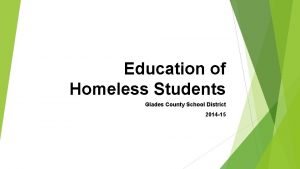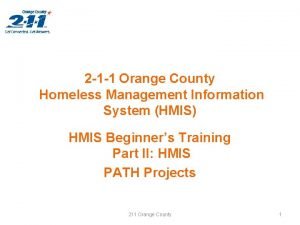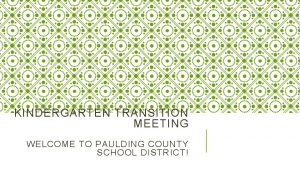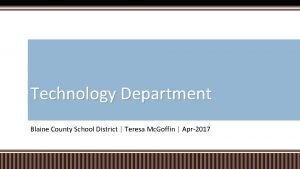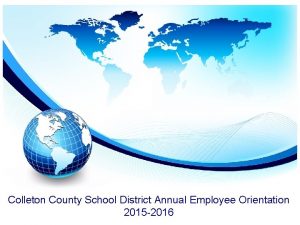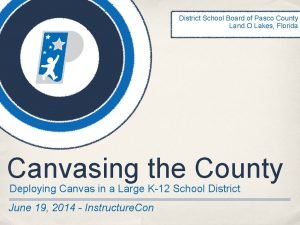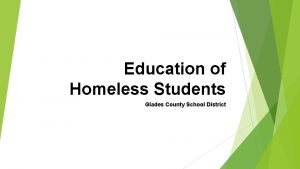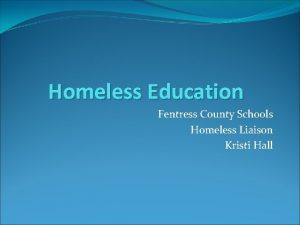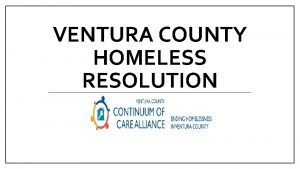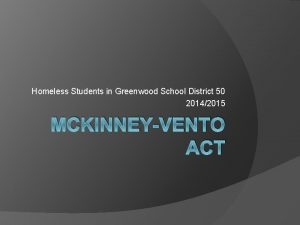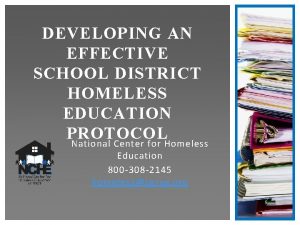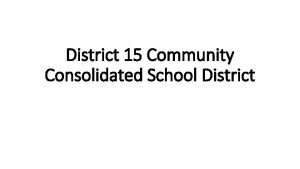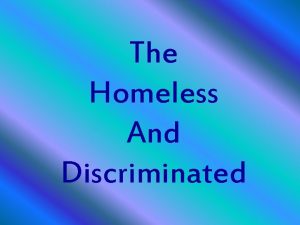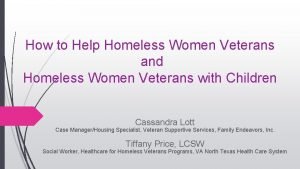Education of Homeless Students Glades County School District












- Slides: 12

Education of Homeless Students Glades County School District 2014 -15

The Mc. Kinney Act The first federal law to directly impact the education of students experiencing homelessness was enacted in 1987 as part of the Stewart B. Mc. Kinney Homeless Assistance Act. The Mc. Kinney Act, which originally contained 15 programs designed to address the needs of homeless persons, contained a subtitle with the purpose of ensuring that children and youth experiencing homelessness could enroll in school without barriers. Since the initial passage, the homeless education law has been reauthorized three times with stronger and more specific requirements for state educational agencies (SEAs) and LEAs to ensure the immediate enrollment, school stability, and academic support needed to increase the educational success of homeless children and youth.

The Mc. Kinney-Vento Act provides a number of LEA requirements for serving homeless children and youth in 42 U. S. C. § 11432(g)(3). The tasks outlined in the law are summarized below. Universally, LEAs must: • designate a staff person to carry out the duties described in the Mc. Kinney-Vento Act as the local homeless liaison • continue the student’s education in the school of origin or a local public school that stably housed students in the area are eligible to attend • make school placement decisions based on the best interest of the child or youth • Best interest provisions require LEAs to keep a homeless child or youth in the school of origin, to the extent feasible, except when doing so is contrary to the wishes of the student’s parent or guardian • to provide a written explanation, including a statement regarding the right to appeal, to the parent or guardian of a homeless student or to an unaccompanied homeless youth, if the LEA sends the child to a school other than the one requested; and to ensure, in the case of an unaccompanied homeless youth, that the local liaison assists in placement or enrollment decisions and considers the views of the youth Regarding enrollment and records, LEAs must: • immediately enroll the child or youth, even without records that are normally required • contact the school last attended for relevant records • assist with obtaining immunizations or immunization records • make records available in a timely fashion when the child or youth enrolls in a new school or LEA To mediate enrollment disputes, LEAs must: • enroll the child or youth in the school in which enrollment is sought • pending the resolution of the dispute • refer the child, youth, parent, or guardian to the local liaison to carry out the dispute resolution process • ensure liaisons assist an unaccompanied youth during the dispute process Coordination provisions require LEAs: • to coordinate with local social service and housing agencies. Comparable services provisions require: • LEAs to provide services comparable to those received by non-homeless students

LEA Requirements Mandated for Inclusion in Education • homeless children and youth are provided opportunities to meet the same state academic achievement standards as all other students • homeless students are identified and their special needs assessed • disputes are resolved promptly • activities take place to heighten the awareness of school personnel of runaway and homeless youths • homeless children and youth participate in nutrition programs • homeless children have access to the same public preschool programs as non-homeless children • homeless youth, both enrolled and not currently enrolled in public schools, are identified and provided equal access to appropriate secondary education and support services • eligible homeless children and youth have opportunities to participate in before- and after-school care programs • enrollment delays caused by immunization and medical records requirements, residency requirements, birth certificates or other records requirements, guardianship issues, or uniform or dress code requirements are eliminated • LEAs will develop, review, and revise policies to remove barriers to the enrollment of homeless children and youth • homeless children are not segregated or stigmatized • local liaisons are appointed in every school district • transportation is provided, at the request of a parent or guardian (or liaison in the case of an unaccompanied homeless youth), to and from the school of origin

THE SCHOOL BOARD POLICY OF GLADES COUNTY Homeless Students The School Board of Glades County shall ensure that homeless children and youth, including preschool-aged children, are afforded the same free, appropriate public education as provided to other students and have access to the education and other services that such students need to ensure that they have an opportunity to meet the same challenging Florida student academic achievement standards to which all students are held. Homeless students shall not be stigmatized or segregated or separated into other educational programs on the basis of their status as homeless. This district shall establish safeguards that protect homeless students from discrimination on the basis of their homelessness. The district will remove barriers that affect the enrollment and retention of homeless students. (1) Definitions The District homeless education liaison shall make a final determination of homeless status on a case-by case basis. (a) The Mc. Kinney-Vento Act defines homeless students as individuals who lack a fixed, regular, and adequate nighttime residence and includes children and youth who: 1) are sharing the housing of other persons due to loss of housing, economic hardship, or a similar reason; 2) are living in motels, hotels, trailer parks, or camping grounds due to the lack of alternative adequate accommodations; 3) are living in emergency or transitional shelters; abandoned in hospitals; or awaiting foster care placement; 4) have a primary nighttime residence that is a public or private place not designed for or ordinarily used as a regular sleeping accommodation for human beings; 5) are living in cars, parks, public spaces, abandoned buildings, substandard housing, bus or train stations, or similar settings; and 6) are migratory children who qualify as homeless because the children are living in circumstances described in 1) through 5). (b) The term "unaccompanied youth" means a student who is not in the physical custody of a parent or guardian. (c) The term "school of origin" means the school that the student attended when permanently housed or the school where the child or youth was last enrolled. (d) The terms “enroll and enrollment” mean attending school and participating fully in school activities. (e) The term “immediate” means without delay. (f) The term “parent” means parent or guardian of a student. (g) The term “liaison” means the staff person designated by our LEA and each LEA in the state as the person responsible for carrying out the duties assigned to the liaison by the Mc. Kinney-Vento Act.

THE SCHOOL BOARD POLICY OF GLADES COUNTY Homeless Students continued (2) School Selection (a) The District shall, according to that which is in the student's best interest, and if it is the wish of the parent, guardian, or unaccompanied youth, continue the homeless student's education in the school of origin for the duration of homelessness, or enroll the student in a District school in the attendance zone in which the homeless student is actually living on the same basis as other district students. (b) In determining that which is in the best interest of the student, the District shall: 1. To the extent feasible, keep a homeless student in the school of origin, unless doing so is contrary to the wishes of the student's parent or guardian. 2. Provide a written explanation, including a statement regarding the right to appeal, if the District sends a homeless student to a school other than the school of origin. 3. In the case of an unaccompanied student, ensure that the District homeless education liaison helps in placement or enrollment decisions, considers the views of the student, and provides notice of the right to appeal placement and enrollment decisions. 4. The school of origin means the school that the student attended when permanently housed or the school in which the student was last enrolled. The choice regarding placement shall be made regardless of whether the student lives with the homeless parent or guardian or has been temporarily placed elsewhere. 5. The requirements of the Student Assignment Plan for students moving their physical residence from one attendance zone to another, to transfer to a school in the new zone of residence, shall not apply to homeless students. 6. The school selection may be documented through the Student Assignment waiver process. (3) Enrollment The District will immediately enroll homeless students, new to the district, in school, even if they do not have the documents usually required for enrollment, such as school records (includes Individualized Education Plan-IEP), medical and immunization records, birth certificate, other documentation, or proof of residency or guardianship. (a) A homeless student will be assigned to the student's school of origin as requested by the parent or guardian or to the District school in the attendance zone in which the student is actually living and in accordance with that which is in the student's best interest. (b) Homeless students have a right either to remain in their school of origin or to attend school where they are temporarily residing. (c) Homeless students who choose to remain in their school of origin have the right to remain there until the end of the school year in which they get permanent housing. (d) If a homeless student arrives without records, the school shall contact the previously attended school system to obtain the required records and the assigned liaison shall assist the family as needed. (e) The District shall immediately refer the parent or guardian to the district's homeless liaison for children and youth in transition, who will help in obtaining necessary immunizations or records if the student needs to obtain these records.

THE SCHOOL BOARD POLICY OF GLADES COUNTY Homeless Students continued (4) Residency A homeless student is considered a resident if the child or youth is personally somewhere within the district with a purpose to live here temporarily, but not necessarily to remain permanently. (a) The student shall be considered a resident when living with a parent, guardian, or person in loco parentis not solely for school purposes or for participation in extracurricular activities. (b) Homeless students who do not live with their parents or guardians may enroll themselves in school. (c) The address listed on the enrollment forms becomes proof that the student lives in District County, Florida. (5) Guardianship (a) For purposes of school placement, any parent, guardian or person in loco parentis who has legal or physical custody of a homeless child or youth shall enroll that child or youth directly in a District school via the Student Assignment office or school that registers students on-site, if selected. (b) The District Guardian Responsibilities form should be completed within a reasonable period of time for those homeless students who are not accompanied by a parent or guardian, once a child or youth is enrolled in and attending a school. (6) Disputes If a dispute arises over school selection, enrollment, or any issue covered in this policy: (a) The student shall be immediately admitted to the school of origin or assigned zone school as requested by the parent or guardian and transportation provided to and from the school of origin, pending resolution of the dispute; (b) The parent or guardian of the student shall be provided with a written explanation of the District's decision regarding school selection, including the rights of the parent, guardian or student to appeal the decision through the District’s enrollment dispute procedure and the Florida Department of Education’s appeal process; (c) The student, parent or guardian shall be referred to the District Homeless Education Liaison, who shall ensure the resolution process is carried out as expeditiously as possible after receiving notice of the dispute; and (d) In the case of an unaccompanied student, the District Homeless Education Liaison shall ensure that the student is immediately enrolled in school pending the resolution of the dispute. (7) Transportation The District shall ensure at the request of the parent, or in the case of an unaccompanied youth, the District Homeless Education Liaison, transportation will be provided for a homeless student to and from the school of origin as follows: (a) If the homeless student continues to live in the School District, in which the school of origin is located, transportation will be provided.

THE SCHOOL BOARD POLICY OF GLADES COUNTY Homeless Students continued (b) If the homeless student moves to an area served by another district, though continuing his or her education at the school of origin, the district of origin and the district in which the student resides must agree upon a method to apportion responsibility and costs for transportation to the school of origin. (c) If the districts cannot agree upon such a method, the responsibility and costs must be shared equally. (8) Comparable Services Homeless students shall be provided services and educational programs comparable to those offered to other students in the school selected, including the following: (a) Preschool programs; (b) Transportation services; (c) Educational Services for which the student meets the eligibility criteria, including special education and related services and programs for English language learners; (d) Vocational and technical education programs; (e) Gifted programs; (f) School nutrition programs; (g) Title I, Part a programs; and (h) Before- and after-school programs. (9) Preschool Programs The district shall ensure that homeless preschool-aged children and their families have access to educational services for which they are eligible, including preschool programs administered by the district. (10) Homeless Education Liaison The Superintendent shall ensure that there is a District Homeless Education Liaison and his/her duties are communicated to district and school personnel and appropriate community agencies and providers. STATUTORY AUTHORITY 1001. 42, 1001. 43, and 1003. 01(12) F. S. ; 1003. 21 F. S, The Mc. Kinney-Vento Homeless Assistance Act, 42 U. S. C. §§ 11431 – 11436. Title I, Part A of the Elementary and Secondary Education Act, 20 U. S. C. §§ 6311 – 6315. The Individuals with Disabilities Education Act, 20 U. S. C. §§ 1400 et seq. April 6, 2002 Policy of the Child Nutrition Division of the U. S. Department of Agriculture. June 5, 1992 Policy of the Administration for Children and Families of the U. S. Department of Health and Human Services. Adopted: September 13, 2012 GCSB

Homeless Liaison Responsibilities In 42 U. S. C. § 11432 (g)(6)(A), the Mc. Kinney-Vento Act lists the responsibilities of the local liaison. The law states local liaisons will ensure that: 1. Homeless children and youth are identified by school personnel and through coordination with other agencies 2. Homeless children and youth enroll in, and have a full and equal opportunity to succeed in, school; 3. Homeless families, children, and youth receive educational services for which they are eligible, including Head Start programs and preschool programs administered by the LEA, as well as referrals to health care services, dental services, mental health services, and other appropriate services 4. The parents or guardians of homeless children and youth are informed of the educational and related opportunities available to their children and are provided with meaningful opportunities to participate in the education of their children 5. Public notice of the educational rights of homeless children and youth is disseminated where they receive services, such as schools, family shelters, and soup kitchens 6. Enrollment disputes are mediated according to local, state, and federal policies 7. The parent or guardian of a homeless child or youth, and any unaccompanied youth, is fully informed of all transportation services, including transportation to the school of origin

The Non-Regulatory Guidance (ED, 2004) lists the following activities that liaisons must conduct in carrying out their responsibilities: 1. Assist homeless children and youth with enrolling in school and accessing school services 2. Help homeless children and youth obtain immunization or medical records 3. Inform parents, school personnel, and others of the rights of homeless children and youth 4. Work with school staff to make sure that homeless children and youth are immediately enrolled in school pending resolution of disputes that might arise over school enrollment or placement 5. Help to coordinate transportation services for homeless children and youth 6. Collaborate and coordinate with the State Coordinator and with community and school personnel responsible for providing education and related support services to homeless children and youth.

How Can Schools Help? • • • Promote awareness/partnerships by working with the liaison to tap into community and faith-based resources. Know the signs: http: //center. serve. org/nche/downloads/toolkit 2/app 12 b. pdf Be tactful when dealing with parents and students. Promote a welcoming and nurturing environment that will support the disclosure of sensitive information. Be aware of disasters or catastrophic events in the community that may cause homelessness. Ensure the Student Residency form is properly completed during enrollment. Note that the word “homeless” is not used.

Glades County School District Homeless Liaison ___________________ Dr. Thelma Jackson Federal Programs Supervisor 863 -946 -0202 ext. 127 thelma. Jackson@gladesschools. org
 Glades county school board
Glades county school board Coral glades website
Coral glades website Glades crop care inc
Glades crop care inc Alameda county health care for the homeless
Alameda county health care for the homeless Chronically homeless orange county
Chronically homeless orange county Paulding county school calendar
Paulding county school calendar Skyward blaine
Skyward blaine Sumner county school district augmentedreality
Sumner county school district augmentedreality Colleton county school district dress code
Colleton county school district dress code Northern burlington county regional school district
Northern burlington county regional school district District school board of pasco county
District school board of pasco county Estill county school district
Estill county school district Boyle county schools
Boyle county schools
